There has been some renewed interest lately in the origin of Proto-Anatolians, because of the recent lecture by Petra Goedegebuure, associate professor of Hittitology at the University of Chicago: Anatolians on the Move: From Kurgans to Kanesh, given at the Oriental Institute (Feb 5 2020).
I will try to comment on her lecture with a critical view of some of her ideas, keeping in mind reasons for one or the other potential routes, which we can for the moment simplify as Gimbutas’ (1965, 1993) eastern route through the Caucasus vs. Anthony’s (2007, 2015) western one through the Balkans.
While traditional literature is concerned with the impact of western peripheries, the time and place of Common Anatolian (and thus a strong hypothesis for Proto-Anatolian) can only be inferred through the multiple fragmentary documents, hydrotoponymic studies, and hypothesized language contacts (adstrate, substrate, superstrate) of poorly reconstructed pre-classical linguistic communities of the Near East.
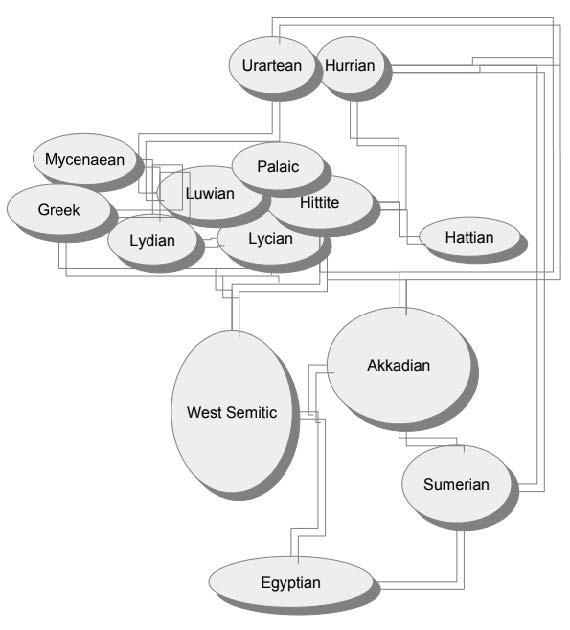
Sections are arranged in a more or less reverse chronological order, to try and trace back the origin of Anatolian speakers:
- Hattians:
- Limited influence on Hittite.
- Acculturated Anatolians.
- Anatolian layer before Hattic.
- Proto-Luwic substrate?
- Palaeolinguistics:
- Population genomics:
- Conclusion.
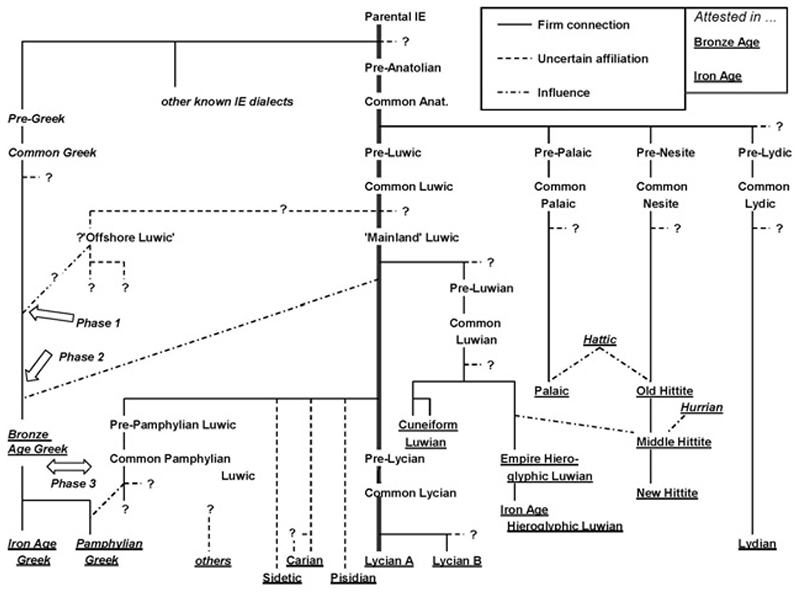
1. Hattians
1.1. Limited influence on Hittite
The cultural merge of Hittites and Hattians is well known, but more interesting are the theories of Goedegebuure (2008) regarding the nature of Hattian–Anatolian contacts:
The influence of Hattian on Hittite was, according to her, quite limited. Arguments contra Watkins (2001) include:
- Tischler (1979) shows that there are about 30 assured Hattian loans in Hittite.
- Oettinger (1999) has shown that -el has an Indo-European origin, whereas the Hattian derivational suffix -il(i-) occurs only in personal names or in lexical borrowings in Hittite.
- Difficult direct comparison of split-ergativity in Hittite with ergativity in Hattian expressed in the prefix chain of the verb.
- Enclitic pronouns and particle chains after the first accented word of the sentence do not correlate well with Hattian’s prefixing nature and with its morpheme chain being an integral part of the verb.
- Hattian pala (sentence and phrase connector) doesn’t show an exact parallel syntactic or semantic identity with Hittite nu (sentence connector; for phrase connector it is matched by -i̯a ‘and, also’).
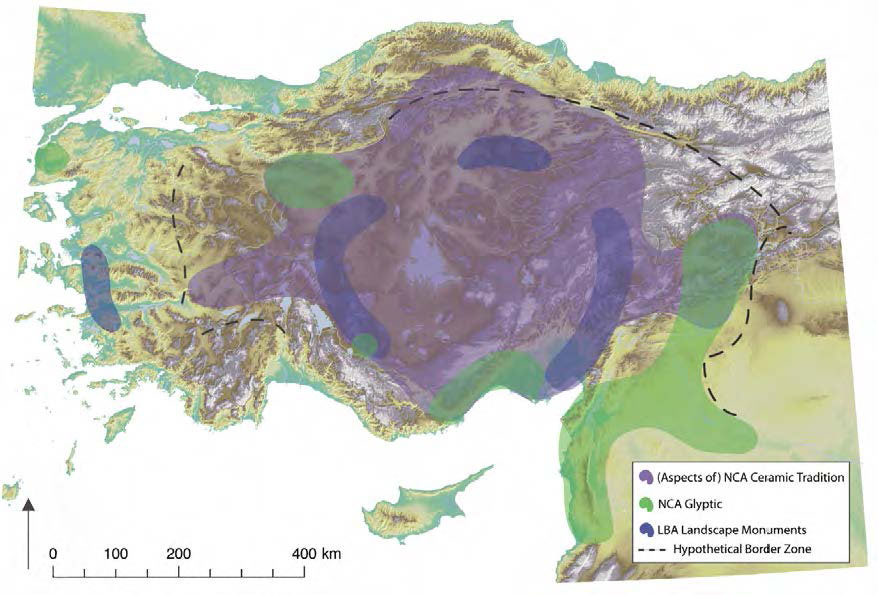
1.2. Acculturated Anatolians
In fact, Hattians were probably acculturated Anatolians:
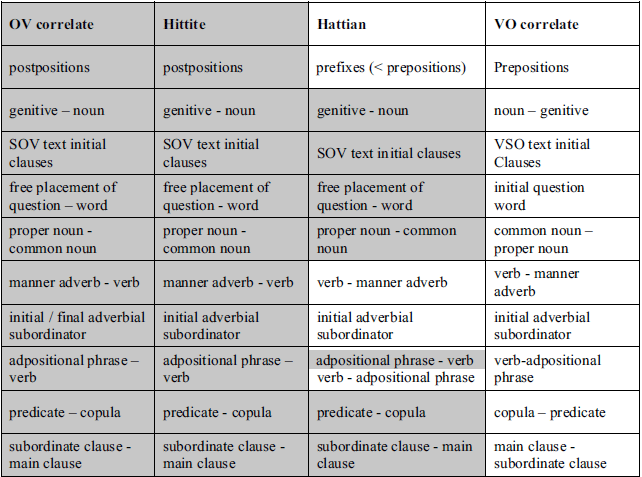
NOTE. For a full discussion of the hypothesized Hattian–Anatolian stratum, see Goedegebuure (2008).
(…) the Hattian language facts may be explained by a language shift from a numerically large and originally subordinate group of speakers of an SOV language to Hattian. This group is in close contact with Hattian speakers, but, because of the group size, not exposed enough to learn the language perfectly on an individual level. This imperfect group learning leads first to grammatical mistakes in the Hattian of the SOV speakers and then in the speech of the Hattian speaking natives. Without lexical borrowings in Hattian this indicates a language shift from the SOV speakers to Hattian in a rather short period of time, maybe even in one generation. The lack of lexical borrowing in Hattian also points at a subordinate sociopolitical position of the shifting SOV speakers (Thomason and Kaufman 1988: 117).
We have a large, originally subordinate immigrant group which has completely merged with Hattian society, and is fully, but not perfectly bilingual in both Hattian and an Indo-European language, either proto-Hittite, proto-Luwian, proto-Palaic, or another Anatolian Indo-European language.
As a result, the native language of this group must have borrowed many Hattian words, and, depending on the length of contact, might also show structural borrowing. But this does not show in the Hittite documents, or Luwian for that matter. I believe that this is caused by the fact that the Hittite language as attested is not the language of the subordinate group, but is the successor of the dialect of Kaneš/Neša, an area in which the Hittites were not subordinate. Unlike their related neighbours, the language of the proto-Hittites of Kaneš would at the most show some adstratum effects due to casual contact, as is of course already mentioned by Melchert (2003b: 21).
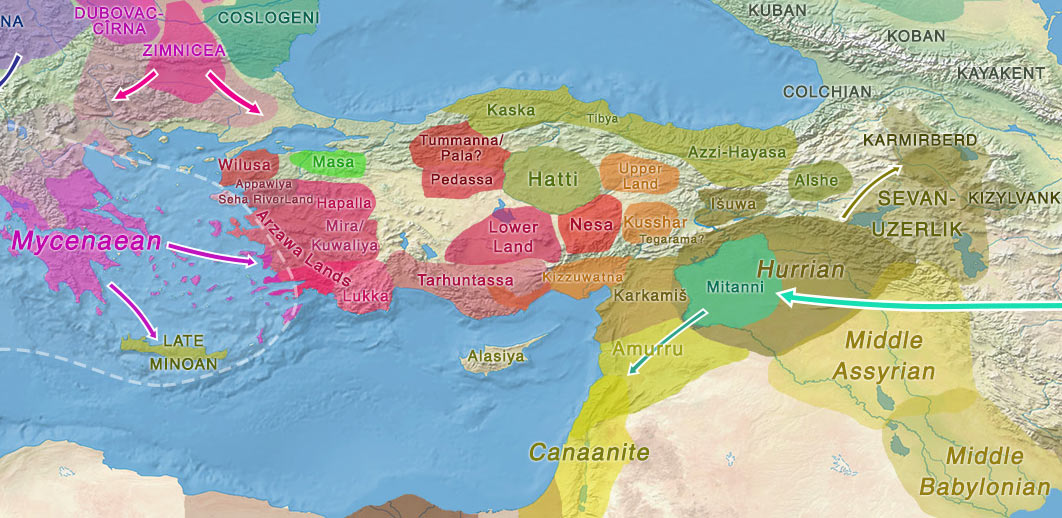
1.3. Anatolian layer before Hattic
(a) The documents from the Colony period seem to provide some evidence for the structural presence of ‘the others’ in the Hattian linguistic area. Indo-European names are not only attested in the Kültepe archives but also in the archives of Boğazköy (Ḫattuš) and Ališar (Capp. A(m)kuwa, Hitt. Ankuwa). (…)
(b) Klinger (1996: 88 w. fn. 30) adduces two letters, one from Mari and one from Kültepe in which the name Ḫattuš is already thematicized as Ḫattuša. The form Ḫattuša instead of genuine Hattian Ḫattuš might indeed show the early presence of Indo-Europeans in the northern part of Central Anatolia, but it does not prove it. Most Old Assyrian references to Ḫattuš are still without the theme-vowel.
(c) Far more telling than the isolated mentions of Ḫattuša, is the name Amkuwa and its variant Akuwa, already attested in Kültepe level II, whereas the Hattian name of this city is Ḫanikku. The mere fact that we do not find the Hattian name in the Colony period points to the early Indo-Europeanisation of this city in the core land of the Hattians.
(d) The other piece of evidence for the presence of (a type of) Hittite speaking population within the bend of the Kızıl Irmak in the Colony period may be the Hittite place name Šuppiluliya “sacred pool”. In view of the fact that Hittite speakers were able to found a village in an originally Hattian area, Alp (1997: 40) concluded that the Hittites must have formed a majority already in the Colony period.
(e) A connected issue is the use of the ethnonym nuwa’um. As it is the only term used by the Assyrians to refer to non-Assyrians, it seems reasonable to take this word as referring to all the natives of Central Anatolia, irrespective of their linguistic and cultural background. Not only are the nuwa’um the only trade associates of the Assyrian merchants, they are also attested in Ḫattuš/Boğazköy and Ališar. The Boğazköy texts predate a destruction layer which is most likely (but not certainly) caused by the devastating attack of Anitta on Ḫattuš(a), as recounted in KBo 3.22 rev. 45-51.70 Since this could mean that Ḫattuš was not yet ‘Hittitized’ by the time the archives came into being (as the name Ḫattuš itself probably testifies, see above), we have again more support for the view that the nuwa’um are just the natives of Central Anatolia.

1.4. Proto-Luwic substrate?
Goedegebuure (2008) agrees with Carruba (1992) that nuwa’um referred originally to Proto-Luwians, with the nisbe-formation necessarily based on a geographical noun base *Nuwa- < *Luwa- instead of Luwiya. This would agree with Assyrians first meeting the Luwians in the 3rd millennium, possibly through the mediation of the Hurrians (who turn initial l- into n-), before extending the term to the autochtonous population of Central Anatolia.
Regarding Palaic and Palaic culture, both play hardly any role in the Old Hittite kingdom, and all traces of the language disappear after that, whereas the number of Luwian loans in Hittite equals that of Hattian, and Luwian itself also borrowed from Hattian, with parallel loans from Hattian into Hittite and Luwian, or from Hattian into Luwian and then into Hittite (Melchert 2003b: 18).
She adduces, for a Hattian-Luwian stratum, that:
- The language of the cult in the Old Hittite period is Hattian, while Hittite is only used in the cult for the pantheon of Kaneš/Neša. But there are Luwian cult recitations for Hattian deities
- A Hittite magical ritual addressed to Ziparwa (the supreme deity of the Palaic pantheon) is found in Luwian and Palaic incantations.
- Luwian religious texts furthermore contain Hattian mythological motifs, again pointing at close contact with Hattian culture (Soysal 2002a:331 n. 44).
- The indigenous Anatolian Telipinu myth and other related Old Hittite compositions show a mixture of Hattian and Luwian motifs.
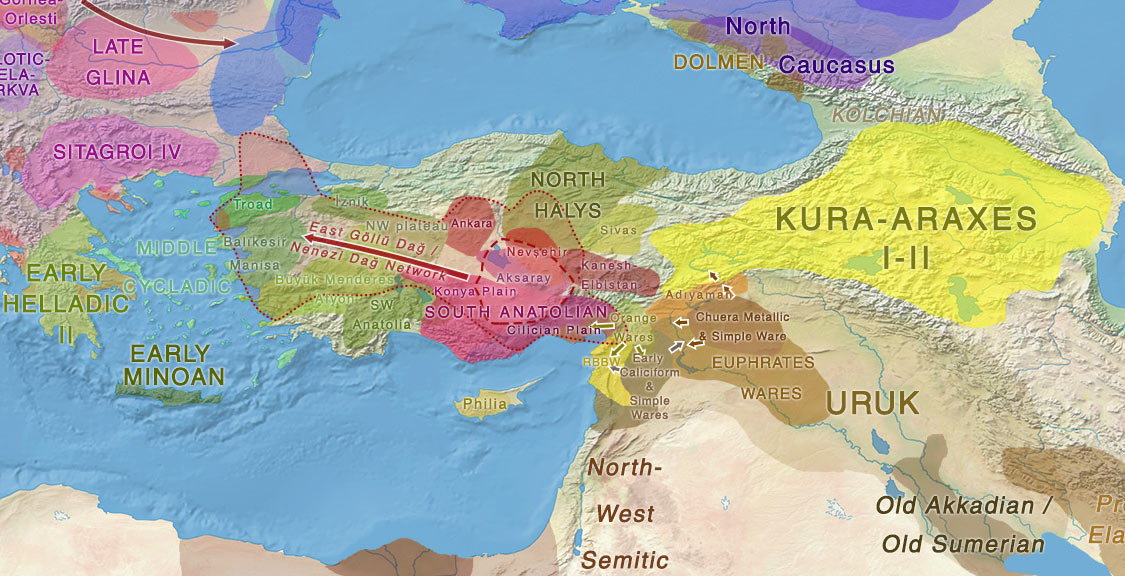
2. Palaeolinguistics
These are the relevant aspects of Anatolian culture in terms of archaeology and linguistic palaeontology:
2.1. Horses and chariots
The horse seems not to play an important part in Hittite rituals, which contrasts with all other surviving (Late PIE-derived) ancient Indo-European branches. On the other hand, Khvalynsk expanded with a marked horse-related symbolism, strongly suspected to be linked to horse domestication and horseback riding.
Despite the lack of essential role among mid-2nd millennium societies, Anatolians kept the Indo-European word for horse; in fact, an archaic athematic version of it. This strongly supports some cultural continuity with the groups that expanded Proto-Anatolian into Asia Minor, and lack of evidence (of horse rituals) is obviously not evidence of absence, not for previous stages of the language.
About chariots, I tend to agree with Goedegebuure (2020) that Anatolians did not necessarily share wagon terminology with Indo-Tocharian; at least not with enough consistency to assert that the words for specific components referred to the same complex object. As we know, the chariot was further specialized much later, and became particularly useful for semi-nomadic pastoralists.
We know that Kura-Araxes expanded with oxcarts and domesticated horses in the late-4th millennium BC (Massa 2016):
Probably invented around 3500 BC in the northern Pontic area, the wheel and its associated technology rapidly spread west and south and by 3000 BC were very common in both Europe and Mesopotamia, as witnessed by several dozen remains of wooden carts, by Late Uruk texts, by a large range of iconographic representations and by wagon models usually in clay (Anthony 2007:61-75; Bondar 2012; Sagona 2013). In west/central EBA Anatolia, archaeological remains of carts have so far not been identified. While Alacahöyük’s cattle burials and paraphernalia found in the graves have often been described as accessories for wagons (e.g. Mansfeld 2001), recent re-interpretation of the possible function of these items and the absence of wooden vehicle remains (in contrast to the well-preserved wooden structure of several graves) suggests otherwise (Bachhuber 2008:190-196; Zimmermann 2008:512-514). However, solid-disk wheel models (fig.3.1) have been found at İkiztepe (c.3500-2900 BC, Alkım et al.1988:pl.75-13), Kanlıgeçit KG 3 (c.2600-2500 cal BC, Özdoğan and Parzinger 2012:fig.193) and Ulucak Höyük “EB II” (c.2700-2400 BC, Abay et al.2000:363). Additionally, wheel ruts carved into the bedrock were apparently associated with the late EBA gate at Limantepe (fig.3.2, Ersoy et al.2011:fig.5). While the evidence for carts is still scarce, and their shape and size unknown, they most probably existed in both western and central Anatolia already by the early 3rd millennium.
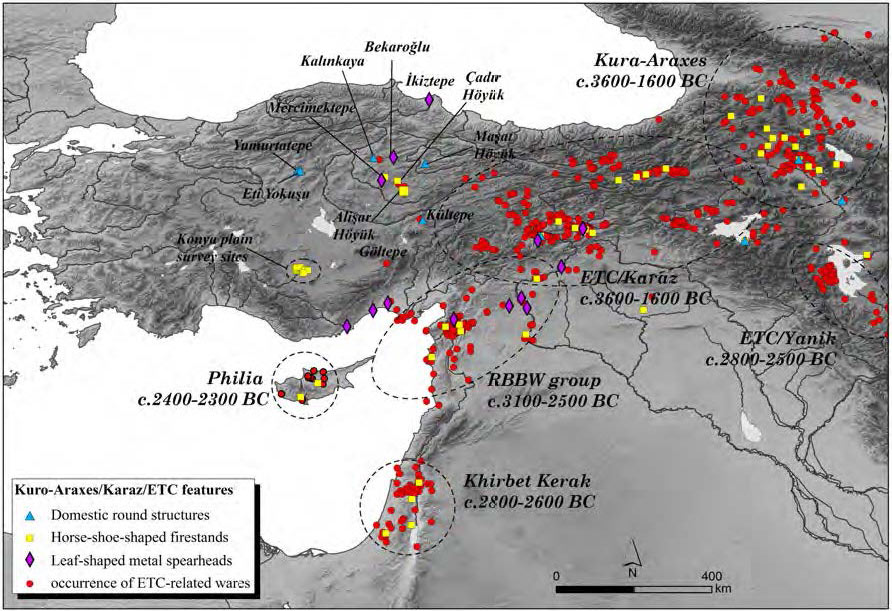
Any linguistic group directly derived from these 3rd millennium Kura-Araxes migrants attested mere centuries after their demise should have kept a strong horse- and chariot-related vocabulary, a terminology that should have remained particularly connected to the language of the North Caucasus steppes (i.e. with Yamnaya), as well as with the whole Southern Caucasus / Northern Iranian region where Kura-Araxes expanded to. This is obviously not the case.
On the other hand, the large, well-published assemblages of Troy, Çukuriçi Höyük, Demircihöyük and Küllüoba suggest that horses were not present in detectable quantities in Western Anatolia during the Bronze Age.
According to Arbuckle (2009), the earliest horse remains have been recovered in Çadır Höyük, a Central Anatolian site from a sealed context radiocarbon dated to the mid-5th millennium cal BCE, increasing in frequency into the LC/EBA, LBA, and Iron Age levels. However, bones metrics and morphology do not exclude the possibility of wild species.
This early presence in central Anatolia, and the continued presence of horses (expanding only after the contacts with Kura-Araxes) is compatible with a Proto-Anatolian culture (possibly from the north?) keeping the ancient term for horse at the same time as its economic and cultural (and consequently mythological) relevance faded.
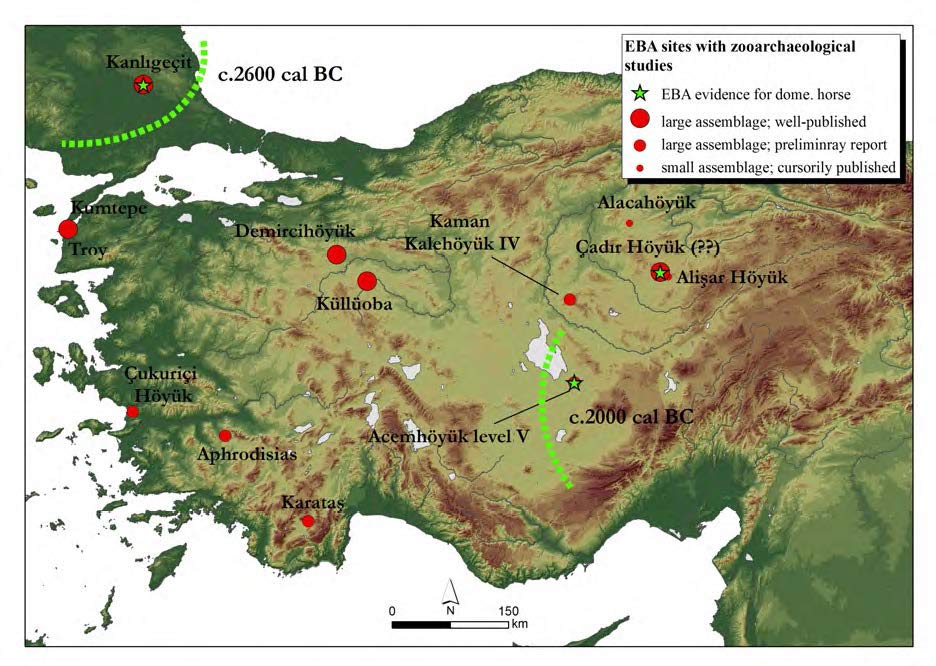
2.2. Agriculture and wine
Anatolian did not share the same, quite limited reconstructed farming vocabulary with Late PIE dialects, which – combined with the recent European Agricultural Substrate and the Asian Agricultural Substrate incorporated into late expanding groups – further strengthens the view that Indo-Anatolians and Late Proto-Indo-Europeans relied mainly on pastoralism as their main subsistence economy.
It is straightforward to assume that Indo-Europeans were not wine cultivators, so we can exclude an origin in Anatolia or the southern Caucasus. The continuity of an original Indo-Anatolian *wéih₁-on-/*wih₁-n-́ ‘twiner, creeping plant, grapevine’ (into the archaic Pre-PAn. *wíh₁on → PAn. *wíyon → Hittite wiyan(a)- ‘grapevine, wine’, Luwian wiyan-i, win-i- ‘grapevine’) probably reflects a continuity of settlement close to the presence of wild vines, which can’t differentiate between a western and an eastern route of expansion from the steppes (see the recent Lipp 2019).
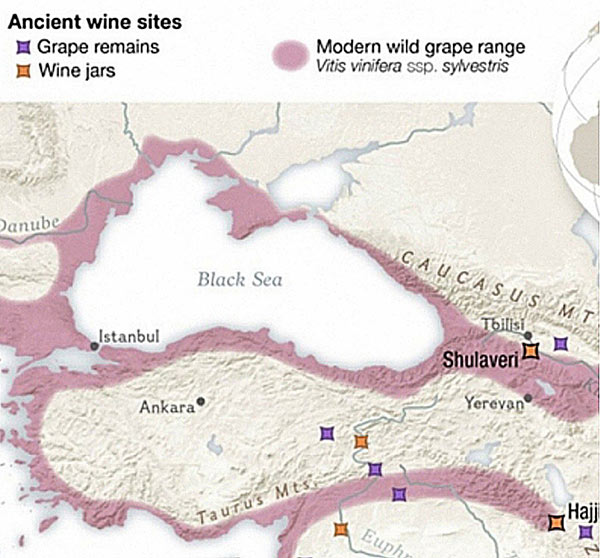
On the other hand, Hattian shows traces of commercial contacts with the east in the mid- to late-3rd millennium BC, supported by the borrowing of karam(u) from Akkadian karānu.
NOTE. For more on the emergence of wine cultivation and its commerce, see e.g. Stephen Batiuk’s 2018 conference at the Oriental Institute Exploring the Roots of the Vine: The History and Archaeology of the Earliest Wines.
Goedegebuure’s (2020) assessment of language contacts suffers from the same ill-conceived reasoning she warned against in her 2008 paper, as she fast-forwards to a very simplistic pattern of geographic-linguistic interference. Roughly: if Hattians “from the north-west” borrowed the Akkadian word “from the south-east”, (Common?) Anatolian could not be “in the middle”. That, to put it mildly, has no sense: chronologically, geographically or culturally.
NOTE. Remember that Goedegebuure’s aim during the conference is to dismiss an origin in Neolithic Anatolia, and to prove a Steppe origin for Proto-Anatolians, so her main argument here is to discard that they were local farmers. She doesn’t even seem to seriously consider a western route of expansion.
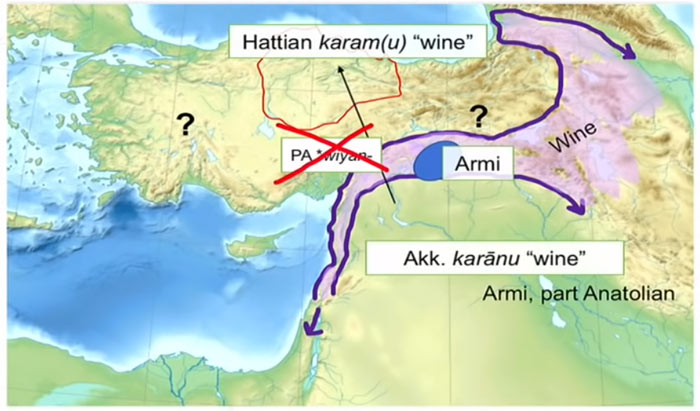
In fact, it is very likely that the etymologically isolated Semitic *win/*waynu ‘wine’ was borrowed from Indo-European, and that Proto-Kartvelian *γwinyo ‘wine’ is a loanword from a Late PIE source north of the Caucasus, which puts the presence of Indo-European languages rather to the north and/or west of the wide Kura-Araxes presence in the Middle East.
NOTE. As to why a Mycenaean Greek form *wóinos could be preferred, see Lipp (2019). On the other hand, Oettinger (2003) already offered the hypothesis of vowel braking from a common Indo-Anatolian *wóih₁nos ‘wine’ → PAn *wēno → Hittite wiyan(a)- (breaking); *wóih₁nos → *wóih₁ni ‘grapevine’ → PAn *wēni- → Luwian *wīni- → HLuw. wiyan-i (breaking), by restitution also wīni-. These alternative reconstructions for Anatolian dialects – and even Lipp’s ones – seem to me compatible with the Semitic forms.
Furthermore, there were also intense (East) Semitic contacts with Anatolian, possibly most mediated by Hurrian (see e.g. Dardano 2018), which is in line with the reconstructed linguistic landscape of Anatolia for the early 2nd millennium BC, and can be used to infer contacts of Anatolian and Semitic in Southeastern Anatolia and Northern Syria in the late 3rd millennium BC.
2.3. The Aegean-Anatolian language cluster
Fragmentary languages are notoriously difficult to study, especially when there is no clear way to relate them to other well-known ancient languages or language families:
- Hattian might have been related to Northwest Caucasian (Chirkiba 1996) – much like Maykop is believed to have been (Bomhard, Anthony 2019) – or, alternatively to (a more contentious) Kartvelian (Girbal 1986, Gabeskiria 1998).
- The Pre-Greek substrate has also been considered to be related to Hattian in Forrer (1938), E. Brown (1974), Schrijver (2007, 2011), Kroonen (2012)… See Tardivo’s summary and an effort to map Pre-Greek hydrotoponyms.
- Hurro-Urartian is believed to be part of an ancient Northeast Caucasian continuum reaching well into the eastern Caucasus.
- Eteo-Cypriot has been compared to Hurrian (Petit 1995, 1997).
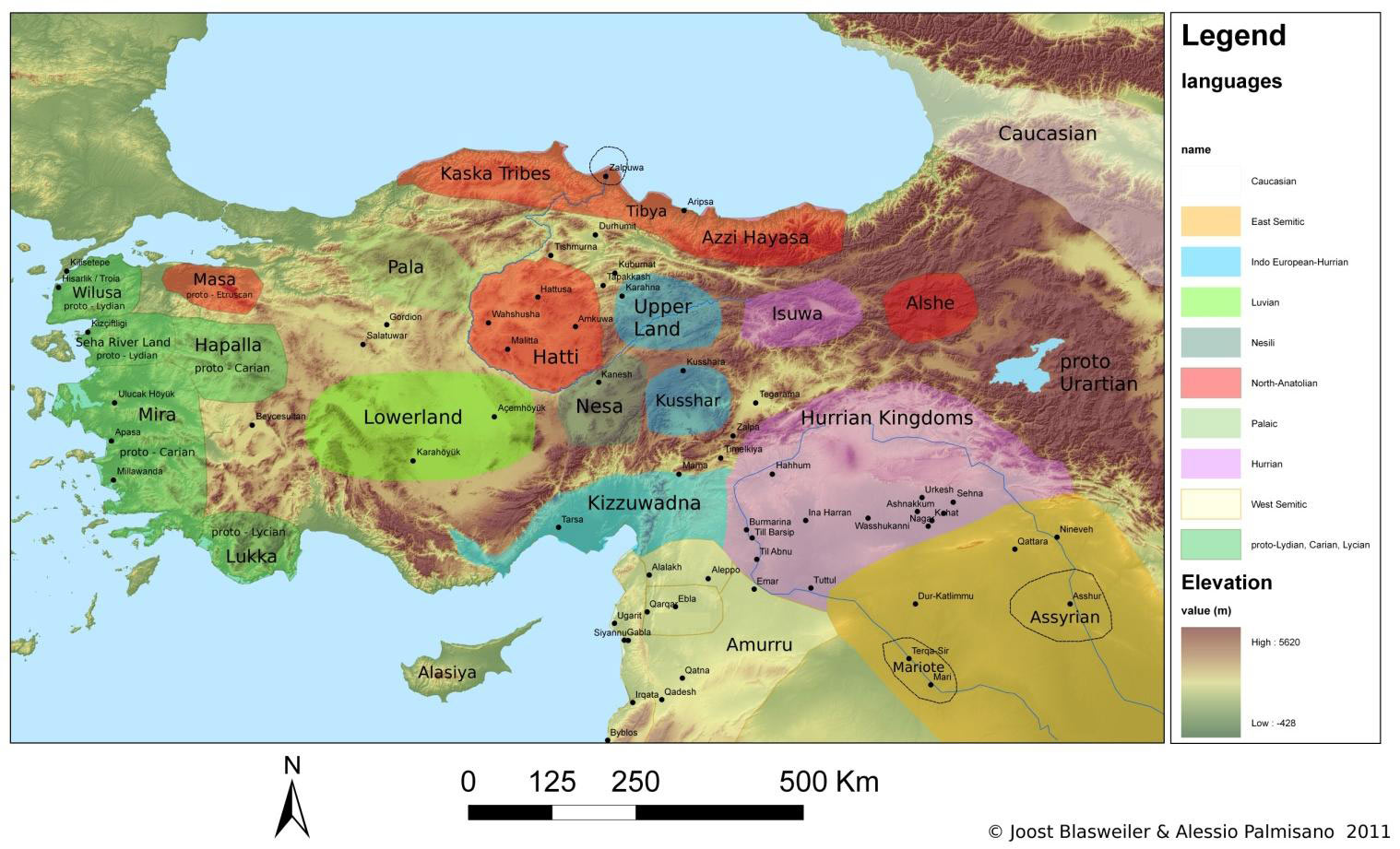
3. Population genomics
Goedegebuure (2020) fails to see that the combination of what we know in archaeology and linguistics, together with population genomics, points strongly to the west rather than the east. I imagine that this is the result of (1) departing from a false dichotomy, a straw man whereby the selected conflicting hypotheses are the 1990s Gimbutas vs. Renfrew; and (2) the evident lack of understanding of the current picture offered by ancient DNA.
3.1. From the East?
Lazaridis et al. (2017) reported an ‘eastern’ (Iran_N/CHG-like) ancestry arriving in the Aegean most likely after the sampled Final Neolithic (Anatolia_N-like) population at the end of the 5th millennium BC, and before the sampled 2nd millennium Minoans and Mycenaeans.
Similarly, Anatolia Bronze Age samples from Harmanören Göndürle in Pisidia (ca. 2800-1800 BC), a likely Anatolian-speaking region by that time, share more alleles with Iran/CHG populations than Anatolia Chalcolithic samples; in particular, they share more alleles with Iran Neolithic than Minoans, and are more closely related to Levantines than Mycenaeans. Their lack of ‘northern’ EHG-related ancestry (visible among Mycenaeans) would merely support that the origin of both dialects (Proto-Greek and Proto-Anatolian) have a different chronological origin.
Damgaard et al. Science (2018) reported a similar situation, where five Anatolia_MLBA samples from the Old Hittite period (ca. 1600 BC) show an ancestry closest to previous Early Bronze Age (ca. 2200 BC) and Copper Age samples (ca. 3900-3700 BC) of Northwestern Anatolia, consistent with Anatolian/EEF-like ancestry, and a similar position in the PCA but slightly shifted to CHG samples.
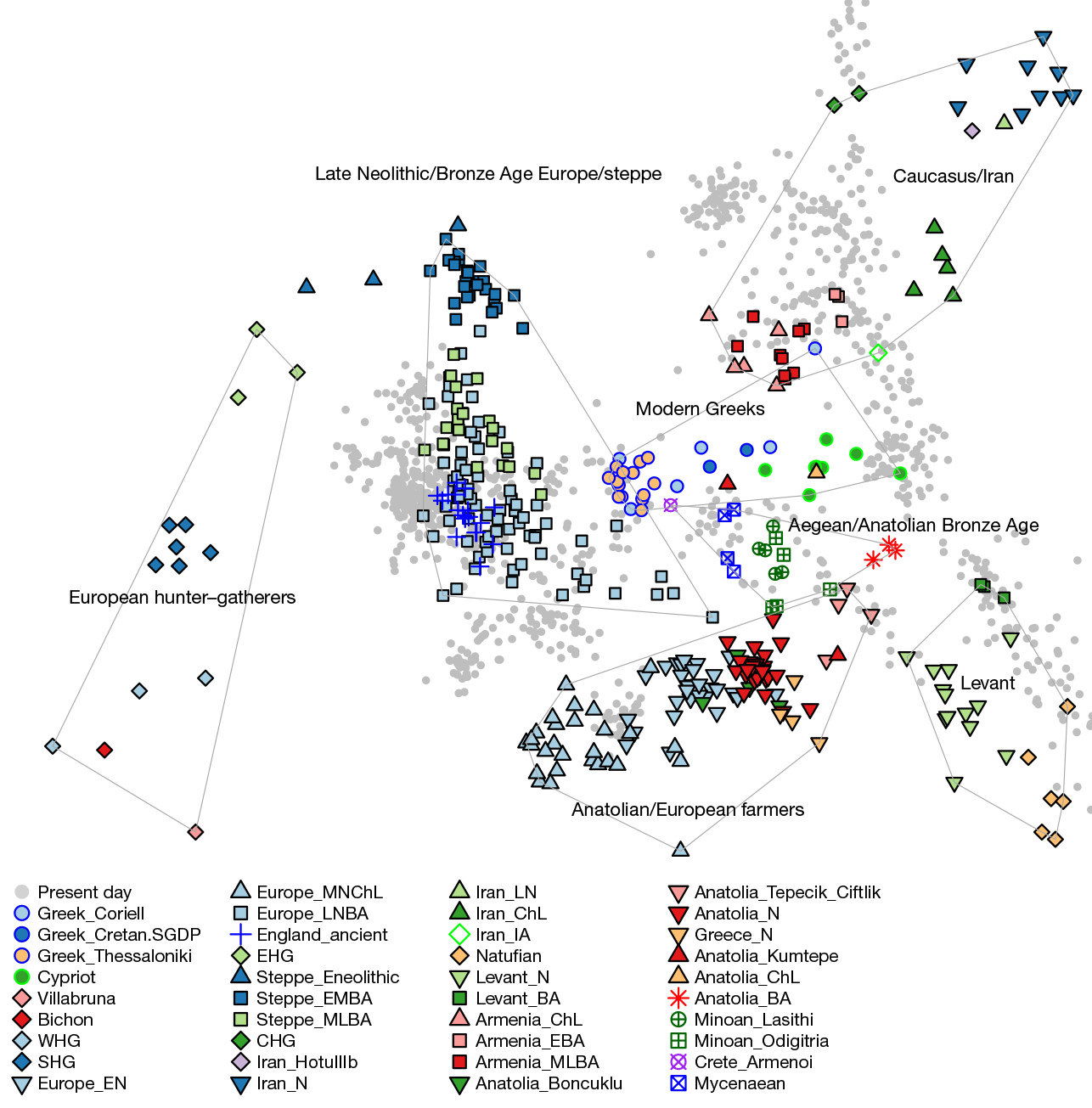
The same paper summarizes its findings:
The CHG-specific ancestry and the absence of EHG-related ancestry in Bronze Age Anatolia would be in accordance with intense cultural interactions between populations in the Caucasus and Anatolia observed during the late 5th millennium BCE that seem to come to an end in the first half of the 4th millennium BCE with the village-based egalitarian Kura-Araxes’ society (…)
Furthermore,
(…) we find no correlation between genetic ancestry and exclusive ethnic or political identities among the populations of Bronze Age Central Anatolia, as has previously been hypothesized.
Against a reasoning based on roughly assessed (and simplistically named) ancestral components, there is a conspicuous lack of proper detailed comparisons with specific populations (say, Kura-Araxes), and Goedegebuure also appears to forget when assessing genomic data that the Hittites emerged after the Kārum period, when Assyrians had dominated over some trade posts where Hittites later emerged. This alone explains the ‘southern’ Iran_Neolithic-like shift visible in the Anatolia MBA cluster.
3.2. From the West
Mathieson et al. (2018) reported Balkan Chalcolithic samples with contributions of Steppe ancestry, which are clearly connected to the Pre-Yamnaya ancestry of expanding Khvalynsk chieftains (see full discussion here).
Wang et al. (2018/2019) showed that the so-called “Steppe ancestry” predates the formation of Khvalynsk and Yamnaya, and might also be found among populations of the Caucasus. It also showed an unpublished Greece Neolithic outlier with Pre-Yamnaya-related ancestry, proving the expansion of Proto-Anatolians up to the southern Balkans (see full discussion of Steppe ancestry evolution).
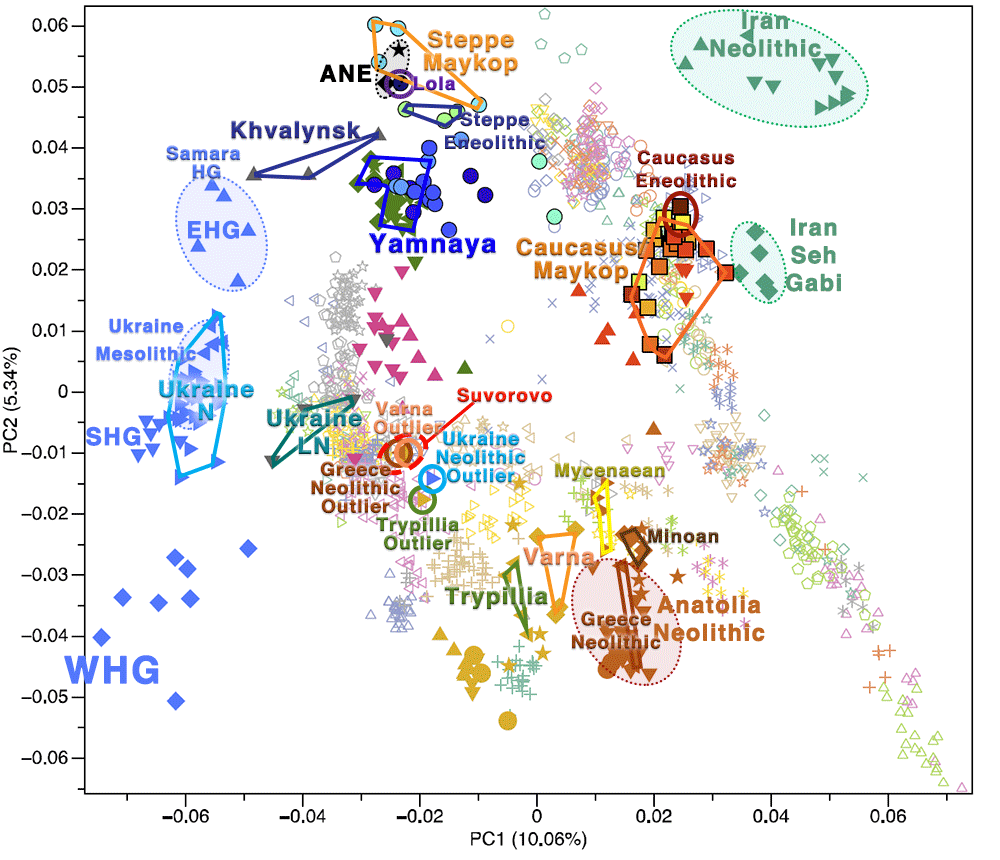
NOTE. Rather than Proto-Anatolian-related peoples, the supervised ADMIXTURE timeline published in Antonio et al. (2019) Supplementary materials, with a yet unpublished Greek sample of the Copper Age, probably shows incoming R1b-L23-rich peoples of Yamnaya ancestry representing Proto-Hellenics from the Balkans in one single EHII–EHIII/MH site, judging by the substantial Steppe-related ancestry:

Despite the questionable nature of the Varna sample, the Pre-Yamnaya-related ancestry found in Sredni Stog and in Balkan Chalcolithic Smyadovo further supports the expansion of Suvorovo-related chieftains up to Macedonia.
The recent paper on Philistines also demonstrates how ancestry of incoming migrants can be effectively diluted among a larger population within a few generations, while male lineages kept popping up in a likely Greek-speaking Levantine population after that period with no traceable Steppe ancestry. This alone easily explains why no particular Steppe-related ancestry needs to be found in historical Anatolian-speaking peoples, and how the finding of a single Steppe-related Y-DNA haplogroup might offer enough information to confirm a Balkan origin.
However, to complicate things further, there are already lineages found in Steppe-related samples among Balkan Neolithic- and Kura-Araxes-related individuals: a sample of hg. R1a-M456(xM417?) in a Criș/Dudeşti sample from Malak Preslavets (ca. 5600 BCE), and another of hg. R1b-V1636 from Kalavan EBA III (ca. 2550 BC), which makes a sure connection with Khvalynsk only through R1b-M269* lineages and/or a clear Pre-Yamnaya ancestry found in some Anatolian Chalcolithic sample unrelated to the Kura-Araxes expansion.
*In fact, the low coverage sample I2181, the Balkan Chalcolithic outlier from Smyadovo with Steppe ancestry, shows derived SNPs up to R1b-M269, and was officially reported as of hg. R-P280: CT+(x3); R-P280(C->G, 1 read); R1b1a1-CTS9018(C->T, 1 read); R1b1a1b-PF6452(G->A, 1 read); which would put it most likely within the P297 trunk, hence probably M269. However, it is also ancestral to P-PF587(G->A,1 read) and P-CTS10081 (C->A,1 read). After decontaminating ancient damage, only derived SNPs up to BT remain. We can reject most EEF-related haplogroups, probably also the coetaneous R1b-V2219, but not I2, which is also found in previous Balkan Neolithic and also Steppe-related Balkan EBA samples.
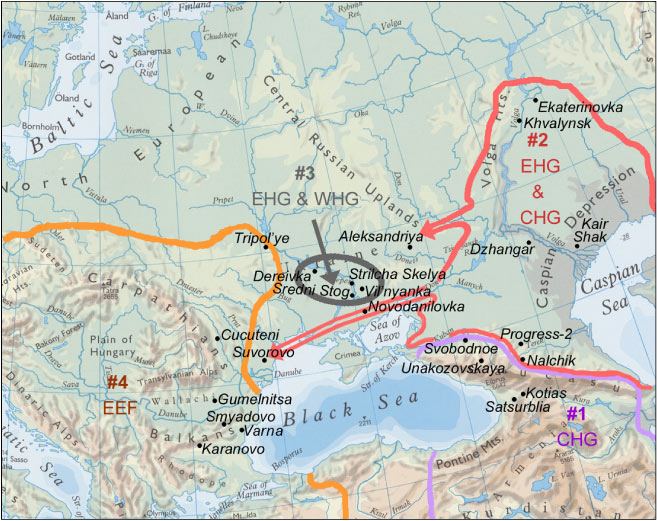
3.2.1. From the Balkans, but when? and where??
Shortcomings of the Balkan origin as set forth by Anthony (2007, 2015), with a proposed late migration of Cernavodă-related peoples into Anatolia, are the chronological and genetic inconsistencies: this hypothesis needs to explain a spread of Common Anatolian from the late 3rd millennium BC through the Bosporus reaching as far as the Euphrates (into the kingdom of Armi) ca. 2500 BC, which is not visible in either genetic inflows or radical cultural changes.
Anhony’s theory could maybe explain Goedegebuure’s Luwian-Hattian stratum as a very recent admixture event – giving enough time for a Common Anatolian split and differentiation within Anatolia – but the Anatolian expansions would nevertheless need to have happened within a few centuries without influencing the genetic profile of MBA Anatolians – at all. The latter is difficult to accept, since Balkan EBA peoples from Bulgaria (such as Ezero-related samples) show significant Steppe-related ancestry in the late 4th / early 3rd millennium BC, probably not (all) directly related to the Yamnaya expansion.
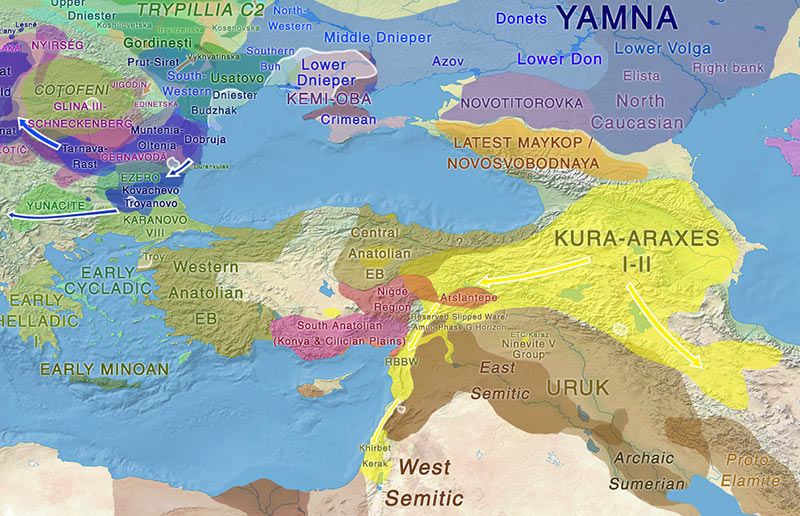
3.2.2. İkiztepe in the Bronze Age
The recent report in Key et al. (2020) of sample IKI003, from İkiztepe (ca. 3340-3100 BC), shows a culture, ancestry, and PCA cluster (intermediate between Armenia_CA and Armenia_EBA) compatible with both (a) a local CHG-like group related to ‘Northern Anatolian’ (Hattic-NW Caucasian–speaking) peoples and (b) a direct expansion of (Hurro-Urartian–speaking) Kura-Araxes-related peoples:
The site covers several mounds and the largest Bronze Age cemetery in Early Bronze Age Anatolia. Initially dated to the 3rd mill. BC, analogies in the metal objects and actual radiocarbon dates indicate that a majority of the graves date to the late 4th mill. BC, i.e. the local transition from late Chalcolithic to the Early Bronze Age. The metal objects from the cemetery are commonly discussed from an Anatolian perspective, but share many elements with the spectrum of contemporaneous Caucasian Kura-Araxes sites.
Grave goods were common in the cemetery and include weapons, spiral objects, amulets, idols, pottery, items of personal adornment (hairpins, rings, necklaces, earrings, and beads). Population subsistence mainly consisted of pastoralism (animal husbandry), fishing, and small scale agriculture.
Despite its low coverage, I’d tentatively assign it to haplogroup I, which – without deeper SNPs – might be related to local Anatolia Neolithic groups, to the Balkan Neolithic, or to Southern Caucasus Chalcolithic samples. Its mtDNA is also related to modern Near Eastern populations.
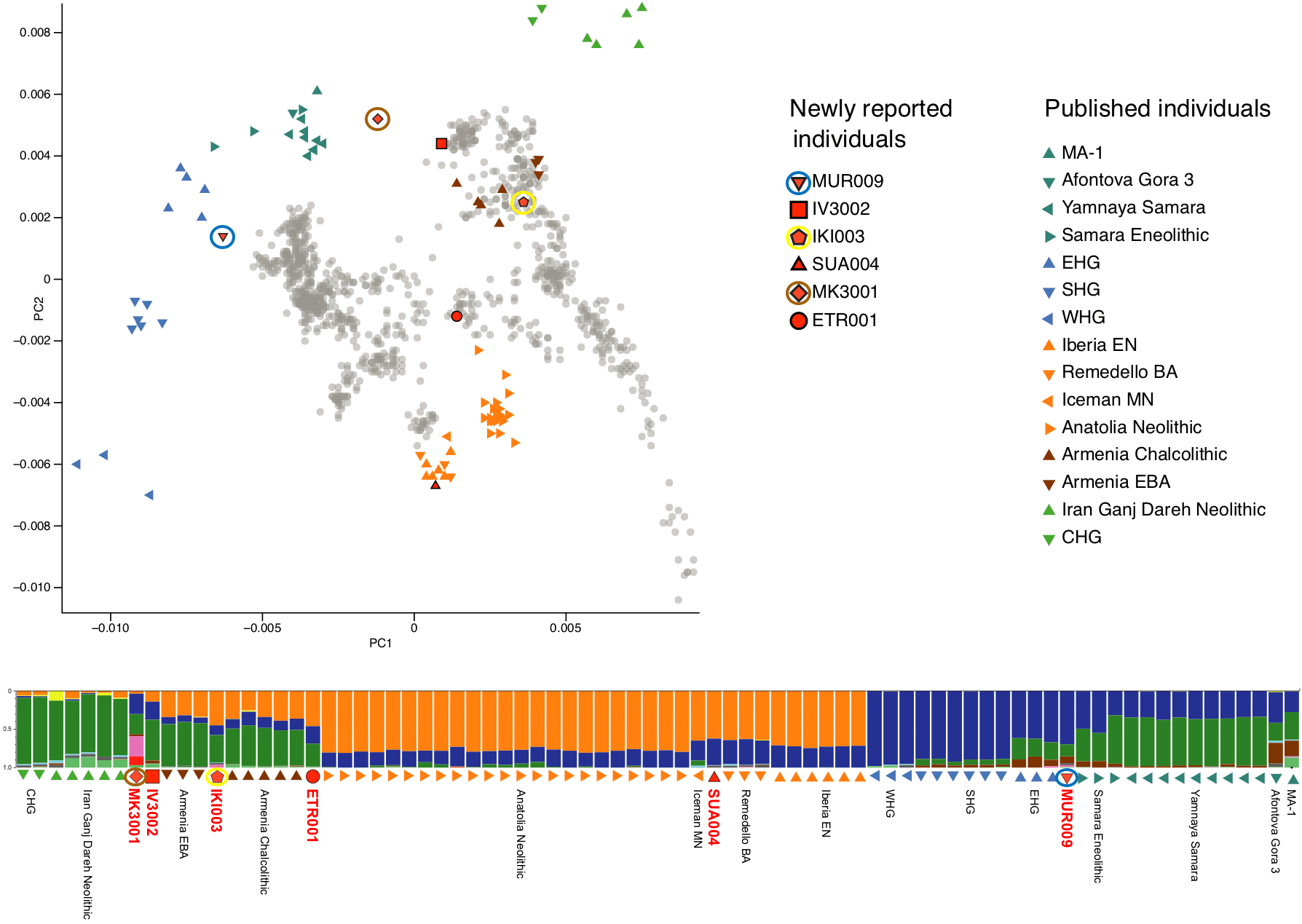
Although admittedly of little value, an ‘eastern’ component proper of EHG-related populations appears in the ADMIXTURE graph above, which could potentially belong to Suvorovo-like peoples of Northern Anatolia replaced by local Hattians (or potentially by Kura-Araxes migrants) in the 4th millennium BC, at roughly the same time as the Hattic-Anatolian stratum must have formed, according to Goedegebuure’s guesstimate.
On the other hand, the same EHG/WSHG-like component can be found in Northern Caucasian groups such as the Steppe Maykop cluster (to which the Mariinskaya sample MK3001 above probably belongs), so it might be directly connected to a ‘Northern Anatolian’ – Caucasian cluster instead.
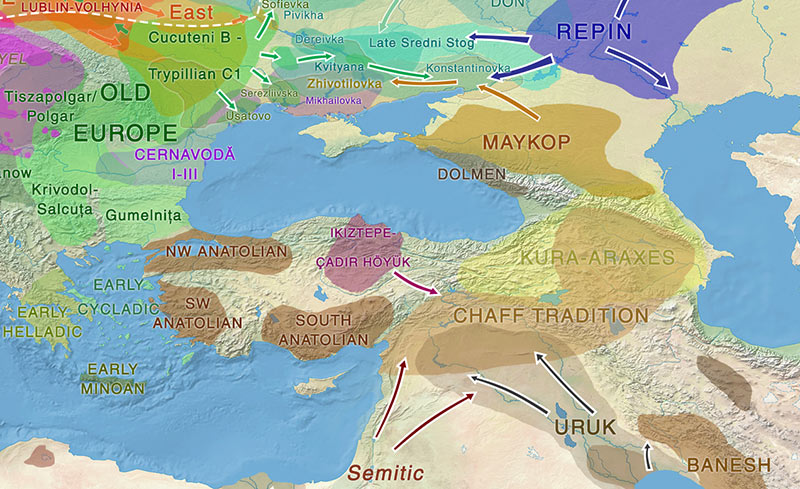
3.2.3. Foundation Myth
İkiztepe is the likely location of BA city of Zalpa (ca. 17th c. BC) mentioned in the tale The Queen of Kanesh, her thirty sons and thirty daughters, which looks like a return myth of Hittites to justify the conquest of the region. There is little historical support for an ancestral origin of Hittites near the Black Sea by the time it was composed.
NOTE. More by Joost Blasweiler from the Leiden University: on Zalpuwa, and on potential connections with Old Hittites.
On the other hand, as Itamar Singer (2007) comments:
Obviously, some of these “return narratives” may have had some factual background, for instance, if one assumes that the 8th century BCE Greek colonization of Pithekoussai and Kyme is related in any way to the Mycenaean presence in Ischia itself and in the nearby island of Vivara.
Probably more interesting about this tale is its support for the avuncular system for rulers – and who they consider a proper heir – which fits the Proto-Indo-European family system of patrilineal inheritance.

Based on the (genetic and archaeological) unlikelihood of a recent massive migration from the Balkans, I proposed a maritime route that must have reached İkiztepe quite early, because it could account for both: a Balkan origin of Proto-Anatolians, and a lack of sizeable Steppe-related ancestry in sampled sites from Western Anatolia in the 5th-3rd millennium BC.
NOTE. The few similar traits in one of the few investigated Chalcolithic sites of Anatolia might not be the real key to the Proto-Anatolian expansion from Varna or a related Balkan Chalcolithic group. It just so happens that Chalcolithic İkiztepe is one of the few chronologically and culturally fitting sites known to date, but it is quite possible that the impact of the initial migration into Anatolia was different.
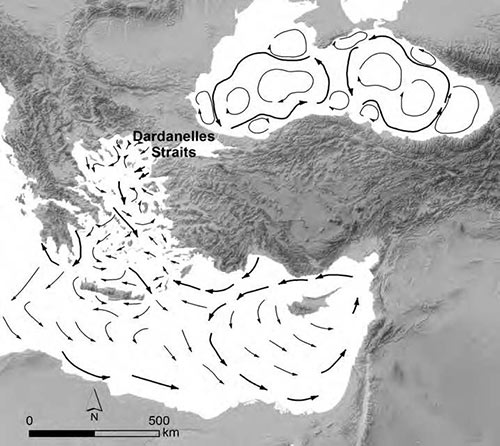
While the introduction of the larger canoes (so-called “longboats”) has been traditionally dated to the EC II (c.2800-2300 BC), recent petroglyphs from Strophilas on Andros may suggest their existence as early as the late 4th millennium, and small boats were available earlier than that.
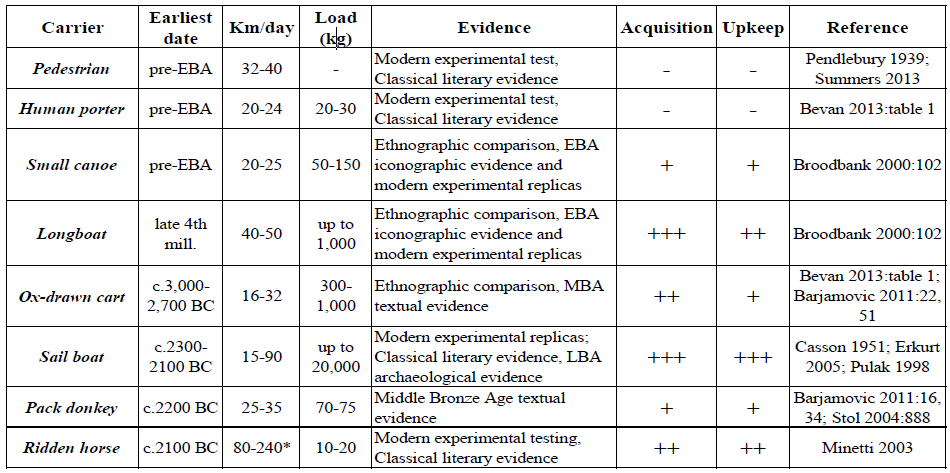
Conclusion
We cannot still say if Proto-Anatolian expanded from the east or from the west. I think that all evidence points strongly to the west, particularly since Chalcolithic samples from the Balkans already prove in genetics the migration waves of Suvorovo chiefs (Anthony 2007), recently confirmed to be R1b-rich peoples of Pre-Yamnaya ancestry (Anthony 2019).
This puts potential Proto-Anatolian-speaking groups as neighbours in immediate contact with Anatolia Chalcolithic cultures at least since the mid-5th millennium BC, with plenty of time for the hypothesized infiltration of its speakers, whether this language replacement happened swiftly or not, sooner or later, with population replacement or through acculturation. That’s what population genomics is for.
Arguments supporting a relationship with Kura-Araxes based on Anatolian-like names in Ebla’s vassal kingdom of Armi – for which there is no precise geographical (and thus prehistorical) origin, and no single clue as to how it received its apparent Anatolian influence – make no sense. The Anatolian of Armi, wherever it was actually spoken, and wherever its rulers and its population had originally come from, merely sets a terminus ante quem of Anatolian presence in Eastern Anatolia. Period.
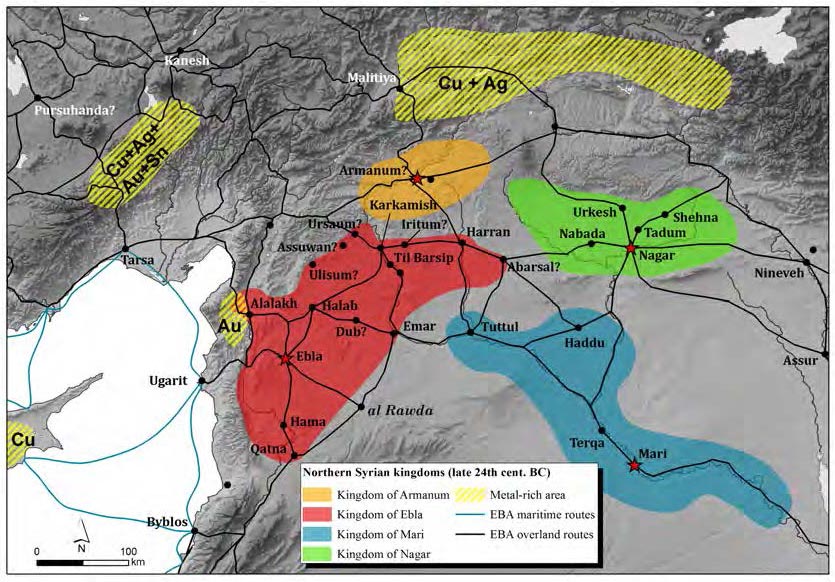
I don’t have any doubts about Petra Goedegebuure’s merits as a Hittitologist, or as a linguist in general, but her discussion of Gimbutas vs. Renfrew in 2020, and her comments about how she came to the idea of Kura-Araxes expanding Proto-Anatolian when looking at a map (“this is something I recently thought of…today…haha”) shows that she doesn’t really care that much about palaeolinguistics as it relates to the Proto-Indo-European question, and is probably focused on Late Bronze Age groups from Anatolia.
It becomes immediately evident that anyone who relies on this conference to support an eastern origin of Proto-Anatolians isn’t interested in the linguistic aspect, either, but most likely on (1) an ethnic idea based on some obsession with simplistically described components, such as “CHG” or “Steppe”; (2) on some nativist idea of where Proto-Indo-European should have emerged; or (3) on supporting an outdated hypothesis for the sake of proving oneself right.
Good luck with any of these “reasons”. For this and for any other question regarding language origins. You will need it.
See also
- “Steppe ancestry” step by step (2019): Mesolithic to Early Bronze Age Eurasia
- Volga Basin R1b-rich Proto-Indo-Europeans of (Pre-)Yamnaya ancestry
- Yamna the likely source of modern horse domesticates; the closest lineage, from East Bell Beakers
- Yamnaya ancestry: mapping the Proto-Indo-European expansions
- Trypillia and Greece Neolithic outliers: the smoking gun of Proto-Anatolian migrations?
- Kurgan origins and expansion with Khvalynsk-Novodanilovka chieftains
- About Scepters, Horses, and War: on Khvalynsk migrants in the Caucasus and the Danube
- Steppe and Caucasus Eneolithic: the new keystones of the EHG-CHG-ANE ancestry in steppe groups
- The Caucasus a genetic and cultural barrier; Yamna dominated by R1b-M269; Yamna settlers in Hungary cluster with Yamna
- Consequences of Damgaard et al. 2018 (II): The late Khvalynsk migration waves with R1b-L23 lineages
- On the potential origin of Caucasus hunter-gatherer ancestry in Eneolithic steppe cultures
- North Pontic steppe Eneolithic cultures, and an alternative Indo-Slavonic model